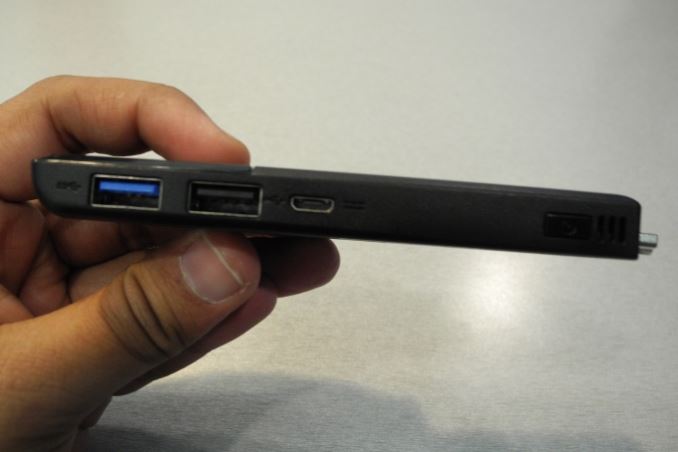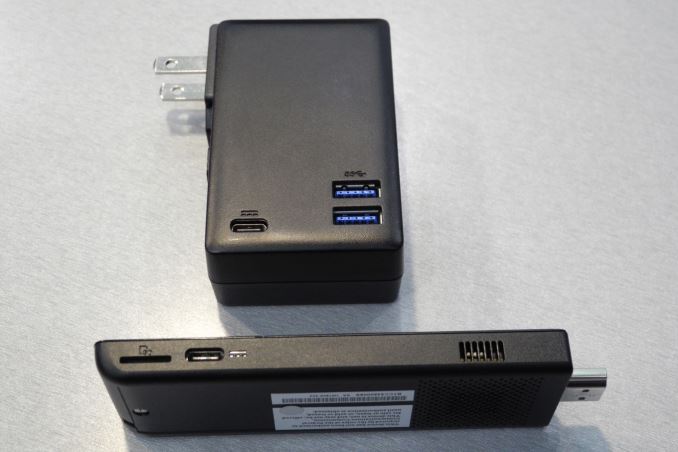Intel Expands Compute Stick Family with Cherry Trail and Core M Models
by Ganesh T S on January 11, 2016 6:00 AM EST- Posted in
- Trade Shows
- Intel
- NUC
- Mini-PC
- CES 2016
- Compute Stick

The desktop PC market is seeing growth only in two areas - the gaming high-end and the mini-PCs (in the NUC form factor). Intel has been strengthening its offerings in the latter space as a system vendor. The NUC has been extremely popular and Intel's partners such as Zotac and GIGABYTE are also enjoying a lot of success with similarly sized systems.
ARM SoC vendors started the trend of HDMI sticks, but Intel joined the game in CES 2015 with the Bay Trail Compute Stick. The first iteration was, to put it kindly, a bit underwhelming, but Intel showed its commitment to the form factor by announcing three new Compute Stick models at CES 2016.
Cherry Trail Compute Stick
This is a straight-on follow-up to the Bay Trail model from last year. The I/O ports and hardware construction are similar, except that the Cherry Trail model is slightly longer and includes a USB 3.0 port in addition to the previously existing single USB 2.0 port.
Other improved aspects include the use of Intel's own 802.11ac Wi-Fi chipset instead of the Realtek one found in the Bay Trail version. Obviously, Cherry Trail's GPU is better than Bay Trail's. However, the cooling fan still remains part of the hardware. The eMMC capacity is only 32GB and the RAM is only 2GB - two aspects that have an artificial limitation imposed on them by Intel's decision to pre-install Windows 10 Home. Even though the information is not public, it is likely that Microsoft mandates neutering of a PC's hardware specifications in exchange for a lower price for the Windows 10 OEM license.
Skylake Core M Compute Sticks
While the Cherry Trail Compute Stick was more or less expected, the Core M-based Compute Sticks were a real surprise. Later this year, Intel will launch two Compute Stick models with a Core m3 and Core m5 vPro configuration respectively. The OS will not be pre-installed, and this means that we don't need the storage or RAM to be limited by anything other than what the hardware design allows. In terms of available ports, the design retains the microSD slot from the other Compute Stick models. However, there is only one USB 3.0 port on the unit itself. Power to the unit is delivered by a USB Type-C connector.
The USB Type-C power adapter also includes two USB 3.0 ports. This is a very novel use of the USB Type-C power delivery mechanism. Intel mainly expects the Core M Compute Sticks to be popular amongst businesses and enterprises (thanks to the availability of vPro).
NUCs
Intel has been shipping the Skylake NUCs for a couple of months now. They had one on display at their booth. Interesting aspects include the presence of a SDXC slot as well as a full-sized HDMI port in the rear panel.
They also talked about the upcoming 'Skull Canyon' mini-PC featuring a 45W TDP Skylake H CPU with Iris Pro graphics. It will not be in the NUC form factor, but will be a slightly larger rectangle with height similar to the current NUCs which don't support 2.5" drives. The unit is still a work in progress, but we expect it to launch in the second half of this year. Unfortunately, Intel didn't allow us to take photographs of the Skull Canyon mini-PC.
On the whole, Intel is showing strong commitment to the mini-PC market segment. This will keep x86 relevant in the home computing space even as ARM continues to strengthen its hold in mobile computing.
















34 Comments
View All Comments
Lerianis - Monday, January 11, 2016 - link
Not a surprise in the slightest. For the vast majority of people, a 300-400 dollar laptop will meet all of their needs unless they are the hardest of hard-core PC gamer.BrokenCrayons - Monday, January 11, 2016 - link
Great article as always! I'd love to see Anandtech review the new models.I'm glad Intel is sticking to the compute stick form factor by expanding it. ATX derived form factor computers aren't generally necessary in the majority of use cases these days since even the lowest end hardware is more than enough computational power for a very large segment of the population. The reduced requirement for materials and lower energy demands are also a good thing. I do wish they'd at least make the Cherry Trail system a passively cooled device (one that doesn't thermally throttle), but maybe that's asking too much of current technology. The other thing I find problematic is the fact that RAM and storage capacity have not increased with the new Cherry Trail model to allow the new processor to really stretch its legs. If that's due to Microsoft's OS pricing, then I have to say that's disappointing because I think it's important and perfectly reasonable to see 4GB of ideally dual channel RAM and 64GB of local storage capacity at the bottom end to mitigate the need to hit flash memory for page/swap and relieve pressure on the end user to fuss over primary disk free space. HP didn't take that route with the refreshed Stream 11 and though the Cherry Trail GPU is more than good enough to support gamer needs, it's hamstrung by the same problems that Intel's lowest end compute stick will also have to cope with. I guess a very tiny USB3 stick can solve most of those problems and Windows 10 is a bit *nix-like in allowing additional space to be grafted in more elegantly, but it doesn't solve the basic capacity problems. I'm also inclined to think the Cherry Trail GPU could really stretch its otherwise constrained legs if it had more memory on dual channel (assuming the paltry 2GB Intel is offering is on a single channel anyway...it might not be).
Shadowmaster625 - Monday, January 11, 2016 - link
2nd half of THIS year? Is Skylake H real or vapor?xthetenth - Monday, January 11, 2016 - link
Using USB-C for power delivery and using that capability to turn the charger itself into a docking station and to keep the stick itself compact is pretty brilliant. I'm looking forward to seeing more devices that put ports on the charging apparatus to allow dock functionality. I'm hoping USB-C makes cheap customer docks a mainstream thing.stephenbrooks - Tuesday, January 12, 2016 - link
I don't really understand why this is useful. There's room on the stick itself for a couple of USB ports (even more so if they're type C). In setups I use, the plug-in charger would be down on the floor or under the desk somewhere, so less convenient than the stick itself, which is just on the back of the monitor. Unless a lot of people have the wall power socket in a really accessible place where they'd want to have USB ports?Murloc - Friday, February 26, 2016 - link
there's space on the stick but maybe not inside of the stick.You also have to account for the bulkiness of devices you attach to it, those may obstruct ports.
I think the point is that you can put your universal keyboard receiver or whatever on the plug-in charger, so that the ports on the stick are free.
Also many people have a wall socket above desk height (e.g. I do) so this may be useful for them.
Basically they're providing options.
zodiacfml - Monday, January 11, 2016 - link
Still expensive for what it is. It is probably popular for signage use. That power adapter with two USB 3.0 ports is cool though.fanofanand - Monday, January 11, 2016 - link
The article didn't mention pricing, are we sure it's too expensive for what it is? Historically that has been true, and it's likely that will be the case here, but it would be nice to know. I think most people have an easy use case for this once the pricing is right, would be sweet if this was the generation that did it.Anonymous Blowhard - Monday, January 11, 2016 - link
I wonder if they've made simultaneous BT/Wifi viable in this model. The original Compute Stick was a laggy mess and throttled almost immediately.mikejbradley - Monday, January 11, 2016 - link
I think everyone reading this forum knows what KODI is, and knows it runs on Linux, Android, MSFT. Nice to know we'll be able to buy Intel TV box sticks running at over 2 GHz on powerful skylake CPU'S, but Octacore ARMs are all that's needed for a nice Android gamer TV stick, and it's gonna be very difficult for Intel or MSFT to beat Google or Amazon running Android......